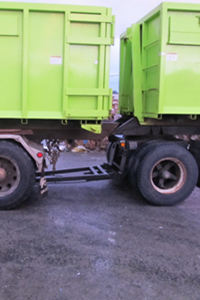Worker fatally injured when trailer rolled toward truck
Date of incident: December 2020
Notice of incident number: 2020154970076
Employer: Waste removal company
Incident summary
The driver of a truck-trailer unit had just emptied the bins on the unit of recyclables and was waiting for the air system in the trailer to charge. He was conducting pre-trip activities on foot at the side of the unit when the trailer rolled toward the truck, crushing him. The driver sustained fatal injuries.
Investigation conclusions
Cause
- Worker crushed against truck by unchocked trailer that rolled. The truck and trailer were parked on a slight incline, and the trailer’s wheels were not chocked. The driver was in the process of connecting the trailer to the truck. The air system in the trailer had to be charged so that the reach that attaches the trailer to a hitch on the truck could be operated. As air accumulated in the trailer’s reservoir, it eventually caused the spring brakes on the trailer to release, and the trailer rolled toward the truck. The driver, who was positioned between the truck and the trailer, was caught between the two when the trailer rolled. The investigation could not determine why the driver had not placed wheel chocks on the trailer to secure it.
Contributing factors
- Lack of effective safe work procedures. The employer did not provide the driver with effective safe work procedures (SWPs) for connecting the trailer to the truck. The driver was following the instructions he had been given for the task, which had covered the use of chocks. Evidence indicates that using chocks on the trailer’s wheels was left to the driver’s discretion. Further, the driver had been instructed to carry out pre-trip tasks that involved walking around the truck and trailer while the trailer’s air system charged. If the employer had performed a proper hazard identification and risk assessment for the task of connecting the trailer, it would likely have identified the hazard of the trailer rolling forward during the process. Then, SWPs could have been developed that either required chocks to be used on the trailer’s wheels all the time in this context, or required the driver to remain in the cab while the trailer’s air reservoir was filling up, or both.
- Failure to identify and repair air leak. Provided the trailer’s front air reservoir was in good working condition, it could have retained sufficient air for as long as an hour after being disconnected from the truck. This way, workers could reconnect the trailer’s reach, which was air powered, to the truck without having to recharge the trailer’s air system. But because this trailer had a leak in its air system, it lost air very quickly, and thus the driver had to wait for it to recharge before connecting the reach. The incident took place during this waiting period. Another of the employer’s workers told the investigation that he had reported the air leak. The employer, if it was aware of the leak (the investigation could not determine if it was), did not take steps to fix it.
- Inadequate corporate oversight. The employer’s occupational health and safety documentation emphasized the necessity of documenting injuries, yet training and instruction, observation behavioural assessments by supervisors, and driver audits went undocumented by the firm. A driver at another of the employer’s B.C. locations had been seriously injured in a similar incident involving a trailer about 10 months before this incident. Managers conducted a job hazard assessment and developed a safe operating procedure for that location to prevent future such incidents. But an employee at the facility where the fatally injured driver worked told the investigation that they never saw a safety alert regarding that earlier incident. The employer recognized the importance of documentation, but failed to identify the lack of documentation with respect to oversight of its workers and incidents in its workplace. Had the facility where the driver’s position was based received a safety alert about the similar incident, there would have been an opportunity to carry out a job hazard assessment for the task of connecting the trailer and to take further steps that could have prevented the incident.
2021-04-22 20:42:33

